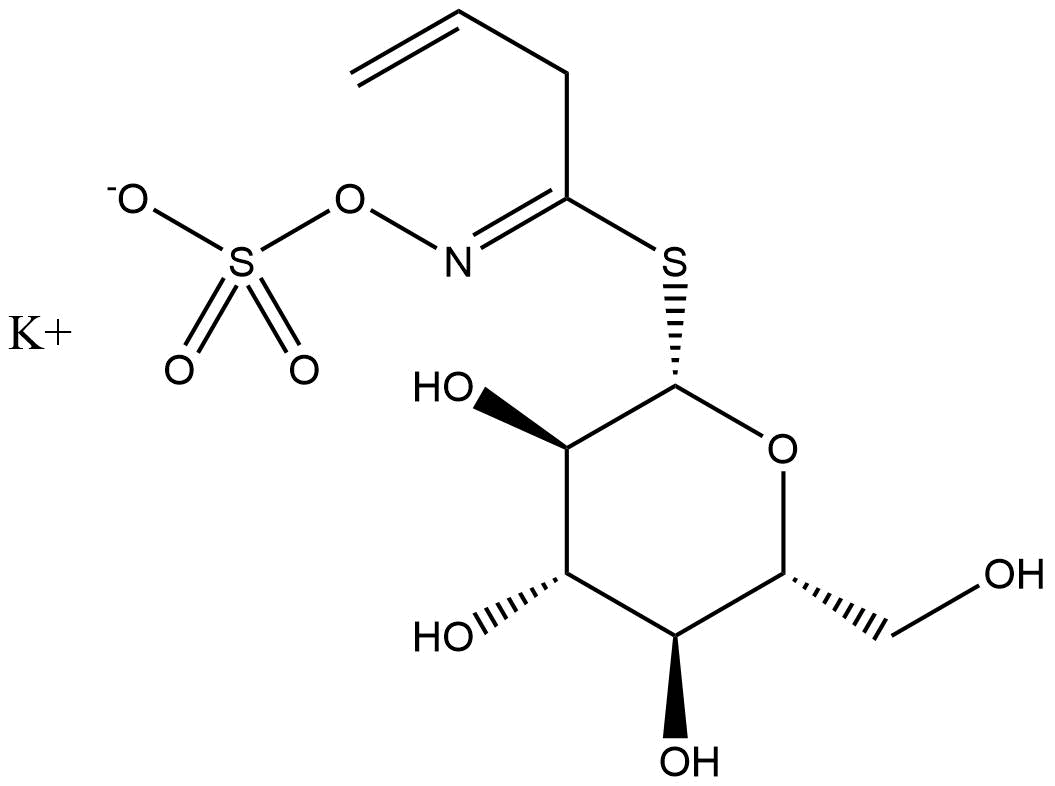
SinigrinCAS No.:3952-98-5
|
||||||||||
 |
|
|
||||||||

| Catalogue No.: | BP1311 |
| Formula: | C10H16KNO9S2 |
| Mol Weight: | 397.454 |
Name: Sinigrin
Synonym name: 2-Propenyl glucosinolate; Allyl glucosinolate potassium; Sinigrine
Catalogue No.: BP1311
Cas No.: 3952-98-5
Formula: C10H17NO9S2
Mol Weight: 397.4
Botanical Source:
Purity: 30%, 50%, 90%, 95%, 99%
Analysis Method: HPLC-DAD
Identification Method: Mass, NMR
Packing: Brown vial or HDPE plastic bottle
Can be supplied from milligrams to grams, up to kilograms.
Inquire for bulk scale.
The purity(assay) of 30%, 50%, 90%, 95% and 98% is available for food, nutrition and cosmetics request, except for R&D and reference standard.
References:
1, Sinigrin, a major glucosinolate from cruciferous vegetables restrains non-enzymatic glycation of albumin.
Int J Biol Macromol. 2016 Feb;83:410-5.
Abstract:
Sinigrin is a major component of cruciferous vegetables such as cabbage, Brussels sprout, mustard greens and broccoli. The present study demonstrates the protective effects of sinigrin against the non-enzymatic glycation of albumin and lens crystallin based on fluorescence spectroscopy, circular dichroism and molecular interaction studies. Sinigrin was found to be a potent inhibitor for both the early (Amadori product) and advanced glycation end products (AGEs). In addition, the in vitro glycation studies of lens crystallin demonstrated the strong antiglycation activity of sinigrin. Computational studies using molecular docking approach revealed the interaction pattern of sinigrin with BSA and the binding affinity of sinigrin was found to be greater than the other potent natural inhibitors of glycation such as quercetin, apigenin, and curcumin.
KEYWORDS:
Advanced glycation end products; Albumin; Sinigrin
2, Sinigrin and Its Therapeutic Benefits
Molecules. 2016 Mar 29;21(4):416.
Abstract:
Sinigrin (allyl-glucosinolate or 2-propenyl-glucosinolate) is a natural aliphatic glucosinolate present in plants of the Brassicaceae family, such as broccoli and brussels sprouts, and the seeds of Brassica nigra (mustard seeds) which contain high amounts of sinigrin. Since ancient times, mustard has been used by mankind for its culinary, as well as medicinal, properties. It has been systematically described and evaluated in the classical Ayurvedic texts. Studies conducted on the pharmacological activities of sinigrin have revealed anti-cancer, antibacterial, antifungal, antioxidant, anti-inflammatory, wound healing properties and biofumigation. This current review will bring concise information about the known therapeutic activities of sinigrin. However, the information on known biological activities is very limited and, hence, further studies still need to be conducted and its molecular mechanisms also need to be explored. This review on the therapeutic benefits of sinigrin can summarize current knowledge about this unique phytocompounds.
KEYWORDS:
Brassicaceae family; anticancer; glucosinolates; mustard; myrosinase; sinigrin
HPLC of Sinigrin
